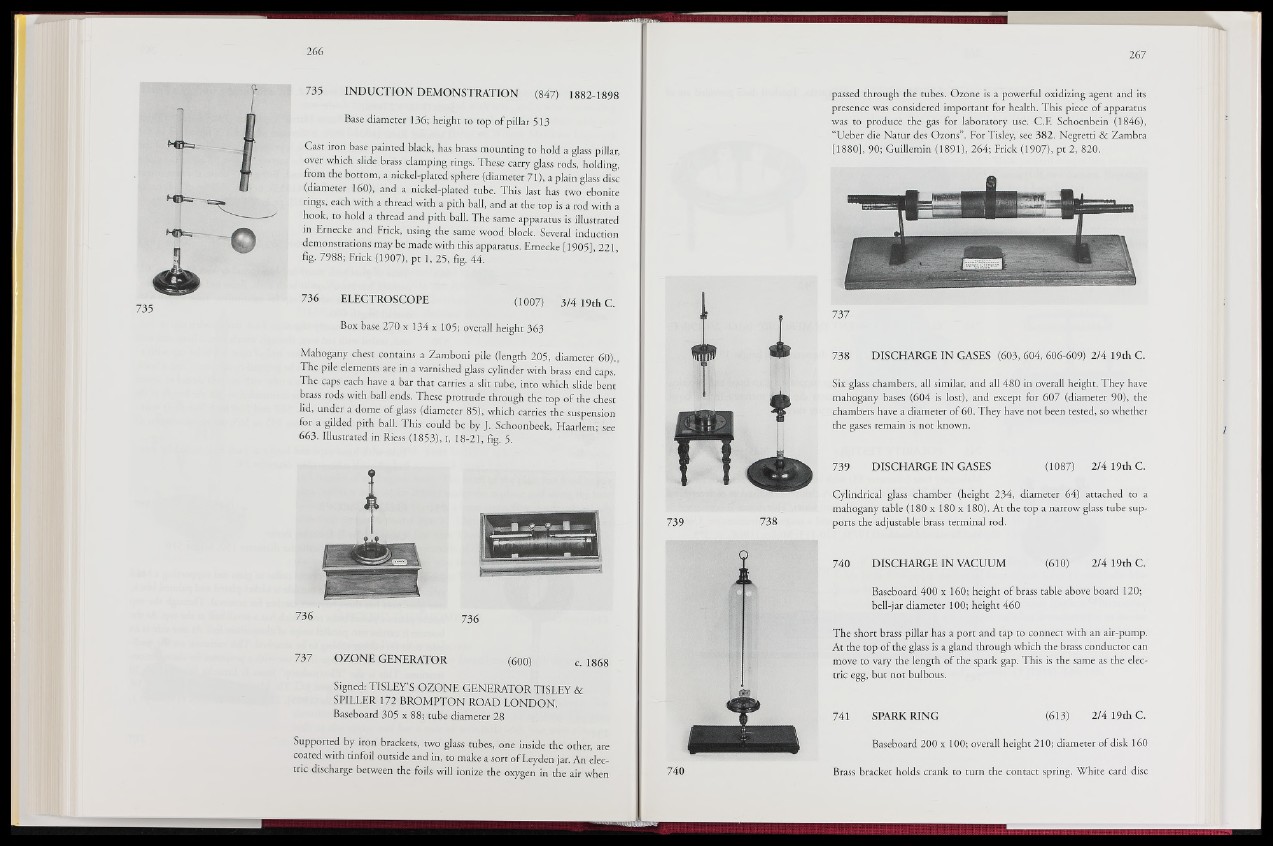
f
735
735 INDUCTION DEMONSTRATION (847)a 1882-1898
Base diameter 136; height to top of pillar 513
Cast iron base painted black, has brass mounting to hold a glass pillar,
over which slide brass clamping rings. These carry glass rods, holding,
from the bottom, a nickel-plated sphere (diameter 71), a plain glass disc
(diameter 160), and a nickel-plated tube. This last has two ebonite
rings, each with a thread with a pith ball, and at the top is a rod with a
hook, to hold a thread and pith ball. The same apparatus is illustrated
in Ernecke and Frick, using the same wood block. Several induction
demonstrations may be made with this apparatus. Ernecke [1905], 221,
fig. 7988; Frick (1907), pt 1, 25, fig. 44.
736 ELECTROSCOPE -fflOOT* 3/4 19th C.
Box base 270 x 134 x 105; overall height 363
Mahogany chest contains a Zamboni pile (length 205, diameter 60).,
The pile elements are in a varnished glass cylinder with brass end caps.
The caps each have a bar that carries a slit tube, into which slide bent
brass rods with ball ends. These protrude through the top of the chest
lid, under a dome of glass (diameter 85), which carries the suspension
for a gilded pith ball. This could be by J. Schoonbeek, Haarlem; see
663. Illustrated in Riess (1853), I, 18-21, fig. 5.
736 736
737 OZONE GENERATOR (600) c. 1868
Signed; TISLEY’S OZONE GENERATOR TISLEY &
SPILLER 172 BROMPTON ROAD LONDON.
Baseboard 305 x 88; tube diameter 28
Supported by iron brackets, two glass tubes, one inside the other, are
coated with tinfoil outside and in, to make a sort of Leyden jar. An eleB-
tric discharge between the foils will ionize the oxygen in the air when
passed through the tubes. Ozone is a powerful oxidizing agent and its
presence was considered important for health. This piece of apparatus
was to produce the gas for laboratory use. C.F. Schoenbein (1846),
“Ueber die Natur des Ozons”. For Tisley, see 382. Negretti & Zambra
[1880], 90; Guillemin (1891), 264; Frick (1907), pt 2, 820.
737
M38 DISCHARGE IN GASES (603, 604, 606-609) 2/4 19th C.
-Six glass chambers, all similar, and all 480 in overall height. They have
mahogany bases (604 is l# s 8 and except for 607 (diameter 90), the
chambers have a diameter of 60. They have not been tested, so whether
the gases remain is. not known.
739 DISCHARGE IN GASES (1087) 2/4 19th C.
739 « 3 8
Cylindrical glass chamber (height 234, diameter 64) attached to a
mahogany table (180 x 180 x 180). At the top a narrow glass tube supports
the adjustable brass terminal rod. '
9 11 „140 DISCHARGE IN VACUUM (610) 2/4 19th C.
Baseboard 400 x 160; height of brass table above board 120;
bell-jar diameter 100; height 460
The short brass pillar has a port and tap to connect with an air-pump.
At the top of the glass is a gland through which the brass conductor can
move to vary the length of the spark gap. This is the same as the electric
egg, but not bulbous.
K 41 SPARK RING (613) 2/4 19th C.
Baseboard 200 x 100; overall height 210; diameter of disk 160
Brass bracket holds crank to turn the contact spring. White card disc